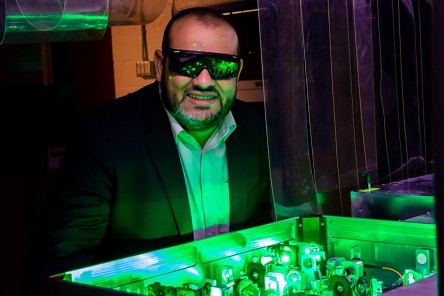Researchers working as part of a multi-institution collaboration led by University of Arizona assistant professor Mohammed Hassan achieved what they said are previously unattainable data transfer speeds from an optical switching mechanism.
The researchers exploited the reflectivity modulation of a fused silica dielectric system in a strong light field to demonstrate on/off-type optical switching with attosecond time resolution. At such switching speed, the work charts a course to deploy optical switches and light-based electronics at petahertz speeds, which are orders of magnitude faster than the current semiconductor-based electronics, the researchers said.
Data transfer speeds exceeding a petahertz are measured at the attosecond timescale — with an attosecond representing one-quintillionth of a second.
The data transfer rates demonstrated by the researchers, therefore, took place at 1 million times the speed of the fastest semiconductor transistors.
Semiconductors in electronics rely on electrical signals transmitted via microwaves to switch — either to allow or to prevent — the flow of electricity and data. These opposite effects are represented as “on” and “off.” Since the invention of semiconductor transistors in the 1940s, technological advancement has centered on increasing the speed at which electric signals can be generated.
According to Hassan, the fastest semiconductor transistors today operate at a speed of more than 800 GHz. Data transfer at that frequency is measured at a scale of picoseconds, or one-trillionth of a second.
Optical switches, such as those activated by terahertz waves, have already been shown to achieve information processing speeds faster than those achieved via semiconductor transistor-based technology. In the recent work, Hassan and his co-authors used ultrafast laser pulses to exploit the oscillation of fused silica reflectivity from maximum to minimum in a half-field cycle timescale. According to the researchers, the current advancement stems from the groundbreaking 2011 demonstration of strong field interaction exploitation to generate extreme-ultraviolet (EUV) pulses by high harmonic generation (HHG) in bulk solids. David Reis of the PULSE Institute for Ultrafast Energy Science at SLAC National Accelerator Laboratory and Stanford University led the 2011 research.
“The [subsequent] development of attosecond EUV and attosecond all-optical spectroscopic measurements provided an access to study and control the charge carrier dynamics and the optical properties of the condensed matter,” the researchers said in their paper.
Though the researchers’ recent work draws from these advancements, it builds on them by demonstrating the potential for switching to occur at ambient conditions, as well as for miniaturization. Hassan told Photonics Media, “The all-optical ultrafast switching in our work by synthesized laser pulse occurs in ambient conditions and can be miniaturized and implemented on a chip. This is considered one of the main advantages compared to HHG technology, which requires special vacuum and setup conditions.”

University of Arizona assistant professor of physics and optical sciences Mohammed Hassan and collaborators devised all-optical switching of a light signal on and off to reach data transfer speeds exceeding a petahertz, measured at the attosecond timescale. The method introduced in the work can be engineered to ultrafast electronics, and it supports ultrafast data communications using such devices and components. Courtesy of the University of Arizona/Mohammed Hassan.
Still, the researchers’ method would require a light-field synthesizer, or four distinct laser sources each with different wavelengths to be located on a chip to achieve complete integration. Hassan said Intel’s 2022 fabrication of an eight-wavelength distributed feedback laser array fully integrated on a silicon wafer represents a promising and encouraging technology development in this area.
The researchers also said that compared to electronic systems that require microwave transmission, the all-optical approach would significantly boost data processing and transformation speeds for light-time distances.
For data encoding, the work yielded a separate breakthrough: The researchers showed an approach to send data in the form of “one” and “zero” — functioning as “on” and “off” — at previously unattainable speeds using light.
Beyond increased switching speeds, Hassan said, the ultrafast optical data encoding result has the potential to resolve additional bottlenecks that hinder typical semiconductor electronic-based datacom. These bottlenecks fall in the areas of transmission impairment due to attenuation, distortion, and noise, as well as security and cost.
The researchers are pursuing industry collaboration, and the University of Arizona is seeking licensees to commercialize this technology, Hassan said. The researchers are looking to take advantage of the ultrafast switching control to develop an ultrafast data encoder and receiver.
Given the current state of Moore’s law, Hassan said, such a collaboration would be timely.
“If we scan current technologies for data commination, electronics, and compute, we see a great need for faster and more secure communications,” he said. “With the current semiconductor technology, the entire focus has been on quantum communication and quantum computers. I think the development of quantum technology requires more time, and a bridge needs to be established to develop realistic quantum electronics and computers. This bridge is ultrafast photonics technology and the establishment of ultrafast light-based electronics.”
The research was published in Science Advances (www.doi.org/10.1126/sciadv.adf1015).